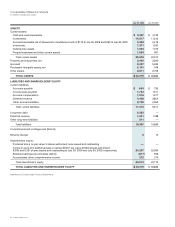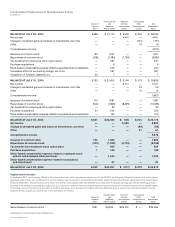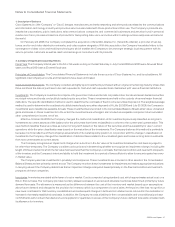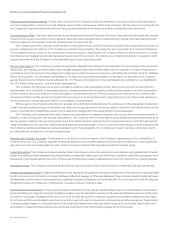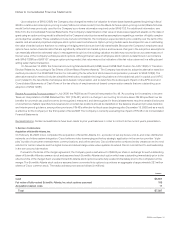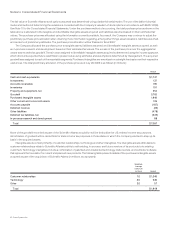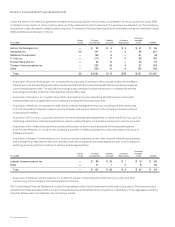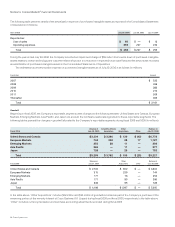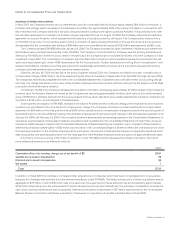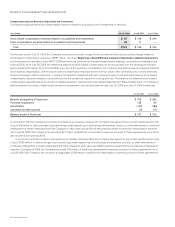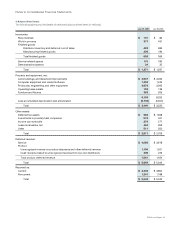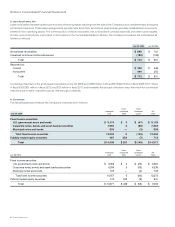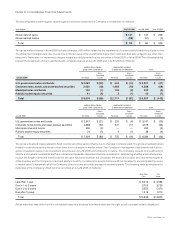Cisco 2006 Annual Report Download - page 48
Download and view the complete annual report
Please find page 48 of the 2006 Cisco annual report below. You can navigate through the pages in the report by either clicking on the pages listed below, or by using the keyword search tool below to find specific information within the annual report.
2006 Annual Report 51
Upon adoption of SFAS 123(R), the Company also changed its method of valuation for share-based awards granted beginning in scal
2006 to a lattice-binomial option-pricing model (“lattice-binomial model”) from the Black-Scholes option-pricing model (“Black-Scholes
model”) which was previously used for the Company’s pro forma information required under SFAS 123. For additional information, see
Note 10 to the Consolidated Financial Statements. The Company’s determination of fair value of share-based payment awards on the date of
grant using an option-pricing model is affected by the Company’s stock price as well as assumptions regarding a number of highly complex
and subjective variables. These variables include, but are not limited to, the Company’s expected stock price volatility over the term of the
awards, and actual and projected employee stock option exercise behaviors. Option-pricing models were developed for use in estimating
the value of traded options that have no vesting or hedging restrictions and are fully transferable. Because the Company’s employee stock
options have certain characteristics that are signicantly different from traded options, and because changes in the subjective assumptions
can materially affect the estimated value, in management’s opinion, the existing valuation models may not provide an accurate measure of
the fair value of the Company’s employee stock options. Although the fair value of employee stock options is determined in accordance
with SFAS 123(R) and SAB 107 using an option-pricing model, that value may not be indicative of the fair value observed in a willing buyer/
willing seller market transaction.
On November 10, 2005, the Financial Accounting Standards Board (FASB) issued FASB Staff Position No. FAS 123(R)-3 “Transition
Election Related to Accounting for Tax Effects of Share-Based Payment Awards.” The Company has elected to adopt the alternative transition
method provided in the FASB Staff Position for calculating the tax effects of stock-based compensation pursuant to SFAS 123(R). The
alternative transition method includes simplied methods to establish the beginning balance of the additional paid-in capital pool (“APIC
pool”) related to the tax effects of employee stock-based compensation, and to determine the subsequent impact on the APIC pool and
Consolidated Statements of Cash Flows of the tax effects of employee stock-based compensation awards that are outstanding upon
adoption of SFAS 123(R).
Recent Accounting Pronouncement In July 2006, the FASB issued Financial Interpretation No. 48, “Accounting for Uncertainty in Income
Taxes-an interpretation of FASB Statement No. 109” (“FIN 48”), which is a change in accounting for income taxes. FIN 48 species how tax
benets for uncertain tax positions are to be recognized, measured, and derecognized in nancial statements; requires certain disclosures
of uncertain tax matters; species how reserves for uncertain tax positions should be classied on the balance sheet; and provides transition
and interim period guidance, among other provisions. FIN 48 is effective for scal years beginning after December 15, 2006 and as a result,
is effective for the Company in the rst quarter of scal 2008. The Company is currently evaluating the impact of FIN 48 on its Consolidated
Financial Statements.
Reclassifications Certain reclassications have been made to prior year balances in order to conform to the current year’s presentation.
3. Business Combinations
Acquisition of Scientific-Atlanta, Inc.
On February 24, 2006, Cisco completed the acquisition of Scientic-Atlanta, Inc., a provider of set-top boxes, end-to-end video distribution
networks, and video system integration. Cisco believes video is emerging as the key strategic application in the service provider “triple
play” bundle of consumer entertainment, communications, and online services. Cisco believes the combined entity creates an end-to-end
solution for carrier networks and the digital home and delivers large-scale video systems to extend Cisco’s commitment to and leadership
in the service provider market.
Pursuant to the terms of the merger agreement, the Company paid a cash amount of $43.00 per share in exchange for each outstanding
share of Scientic-Atlanta common stock and assumed each Scientic-Atlanta stock option which was outstanding immediately prior to the
effective time of the merger. Each unvested Scientic-Atlanta stock option became fully vested immediately prior to the completion of the
merger. The Scientic-Atlanta stock options assumed were converted into options to purchase an aggregate of approximately 32.1 million
shares of Cisco common stock. The total purchase price was as follows (in millions):
Amount
Cash $ 6,907
Fair value of fully-vested Scientific-Atlanta, Inc. stock options assumed 163
Acquisition-related costs 17
Total $ 7,087
Notes to Consolidated Financial Statements





